COACHING
Goals of the Physiotherapist - Long-Term and Short-Term
Andrew Leipus and his 'physio' counterparts at the international level deserve all the praise that they can get for their outstanding contribution to cricket in the area of fitness. They have lent a new dimension to the game with their single-minded objective of making the players of the teams they are attached to, fitter, leaner and consequently, more successful cricketers.The impact that these gentlemen have had on the game can best be gauged at the domestic and junior levels. In India, a country that until very recently was not renowned for producing the fittest of cricketers, virtually every Ranji Trophy and junior side now has a physio who travels with the players, and sorts out the niggling pains and injuries that are part and parcel of a cricketing career in the modern era.
Like the players, whose foremost aim is to win matches, a physio too has a set of objectives.
PHYSIOTHERAPY - SHORT-TERM GOALS:
The goals of early physiotherapy treatment are:
1. To control the acute pain and swelling
2. To tape or support with a brace.
These measures are important to prevent an injury from worsening, or delaying the recovery process.
PHYSIOTHERAPY - LONG-TERM GOALS:
1. The exercise programme is tailored by the physio to strengthen the muscles that surround the injured area, while retracting the injured tissue.
2. For full recovery and return to active sport, the physio can provide a strength training and conditioning programme that includes sports-specific movements, which hgelps a player regain balance and co-ordination.
The physio's job is to enable a player to return to the sport without undergoing persistent pain or recurrence of the injury, both of which can sideline him for the season.

Andrew Leipus Physio of the Indian team tends to Sachin Tendulkar during the 2003 World Cup encounter against Pakistan ASSESSMENT and TREATMENT:
A good physio will be able to assess problematic areas at the earliest. eg:
1- Sprained joints like the ankle, knee, shoulder, thumb.
2- Strained muscles like pulled hamstrings, quadriceps, rotator cuff and groin.
3- Knee pain and patelofemoral pain.
4- 'Overuse' injuries such as Jumpers' Knee, Thrower`s shoulders,
shin-splints, or runners' knee.
5- Tendonitis like achillis tendonitis
6- Chronic and recurrent injuries
7- Neck and back dysfunction
8- Postural imbalance.
IMMEDIATE INJURY TREATMENT BY THE PHYSIO:
The first and foremost job of a physio after an injury occurs is to manage the most dreaded word i.e PAIN:
This is done by following the R.I.C.E. method.
R : Rest (The injured tissue should have a period of rest to heal)
I : Ice (10 mins frequently is better than one long application)
C : Compression (to control or reduce swelling)
E : Elevation (elevate the injured part to help drainage)
INJURY PREVENTION:
1- The physio implements injury prevention and management programmes with every member of the team. These programmes are provided to promote 'safe' sport and assist the players in their pre-match conditioning.
2- The physio conducts educational sessions for pre and post-season fitness-specific activities. These sessions are effective as they help to improve the fitness levels of the players and increase the tonicity and elasticity of the critical functional muscles.
FITNESS TESTING BY THE PHYSIO:
A physio should conduct 'pre-season testing' to identify 'high-risk' players and advise them on conditioning programmes to prevent injury. A physio analyses the predisposing factors of muscle strength - flexibility and balance that affect the movement.
He enlightens the players on aspects of sportsmetrics i.e. injuries that occur without direct contact. The physio trains the players and gives each of them a designed programme to increase their jump-height and reduce the possibility of knee injuries. This programme emphasizes:
1. Proper jumping techniques
2. Reduction in knee injuries.
3. Increase in the jump-height
4. Flexibility and building exercises.
If a fit and healthy body is what the cricketers of today desire, then physiotherapists and their 'trainer' colleagues have an extremely important role to play in helping them satisfy this need.